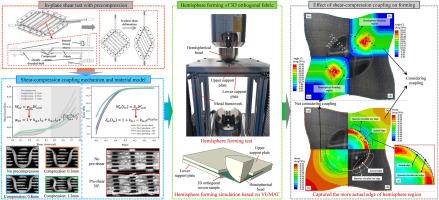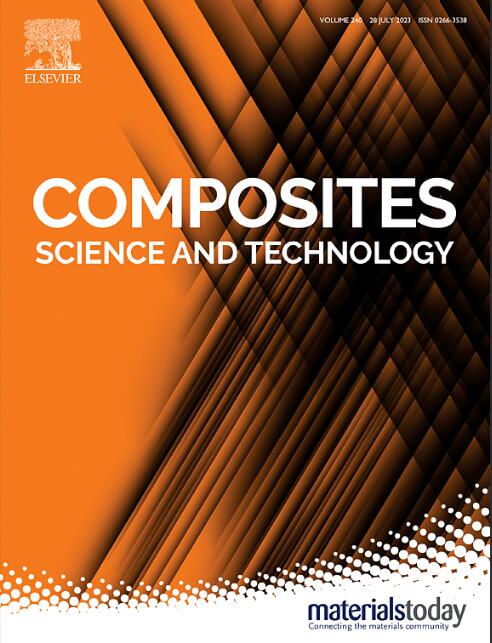A hyperelastic model considering the coupling of shear-compression for the forming simulation of 3D orthogonal composite preforms
IF 8.3
1区 材料科学
Q1 MATERIALS SCIENCE, COMPOSITES
引用次数: 0
Abstract
The shear-compression coupling phenomenon is vital in the forming process of complex 3D woven composite components, but has not been effectively considered in existing macroscopic material models. A hyperelastic material model considering shear-compression coupling is developed here. Firstly, in-plane shear tests on pre-compressed specimens and compression tests on pre-sheared specimens were carried out, respectively. The results show that pre-compression can hinder and promote the in-plane shear deformation before and after shear locking occurs in the fabric, respectively. In-plane shear can contribute to compression. Then, a nonlinear hyperelastic constitutive model is presented and implemented in an Abaqus/Explicit user subroutine. Finally, a simulation study of the hemispherical forming of 3D orthogonal woven fabric was conducted using this model. The simulation results considering shear-compression coupling show more accurate in-plane shear angles and edge shapes compared to those without considering coupling. Moreover, since the shear-compression coupling is considered, the friction between the fabric and the tool needs to be reasonably discussed in the moulding simulation.

考虑到剪切-压缩耦合的超弹性模型,用于三维正交复合预成型件的成型模拟
剪切-压缩耦合现象在复杂的三维编织复合材料部件的成型过程中至关重要,但现有的宏观材料模型并未有效考虑这一现象。本文建立了一个考虑剪切-压缩耦合的超弹性材料模型。首先,分别对预压缩试样进行了平面内剪切试验,对预剪切试样进行了压缩试验。结果表明,在织物发生剪切锁定之前和之后,预压缩分别会阻碍和促进面内剪切变形。面内剪切可促进压缩。然后,介绍了一种非线性超弹性结构模型,并在 Abaqus/Explicit 用户子程序中实现了该模型。最后,使用该模型对三维正交编织物的半球成型进行了仿真研究。与未考虑耦合的仿真结果相比,考虑了剪切-压缩耦合的仿真结果显示了更精确的平面内剪切角和边缘形状。此外,由于考虑了剪切-压缩耦合,因此在成型模拟中需要合理讨论织物与工具之间的摩擦。
本文章由计算机程序翻译,如有差异,请以英文原文为准。
求助全文
约1分钟内获得全文
求助全文
来源期刊

Composites Science and Technology
工程技术-材料科学:复合
CiteScore
16.20
自引率
9.90%
发文量
611
审稿时长
33 days
期刊介绍:
Composites Science and Technology publishes refereed original articles on the fundamental and applied science of engineering composites. The focus of this journal is on polymeric matrix composites with reinforcements/fillers ranging from nano- to macro-scale. CSTE encourages manuscripts reporting unique, innovative contributions to the physics, chemistry, materials science and applied mechanics aspects of advanced composites.
Besides traditional fiber reinforced composites, novel composites with significant potential for engineering applications are encouraged.
 求助内容:
求助内容: 应助结果提醒方式:
应助结果提醒方式:


